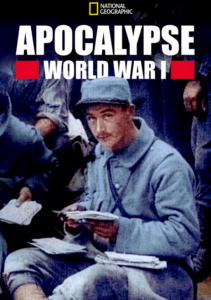The Great War in Color: Apocalypse World War I
Published: 20 June 2022
By Helen Beck
Special to the Doughboy Foundation web site
Apocalypse World War I, airing now on NatGeo, takes its viewers into a fascinating and uncharted look at the events of World War I. Producers used over 500 hours of archival footage for compelling story-telling — including some stunning colorized images of American soldiers and President Woodrow Wilson at the Paris Peace Conference.
 Behind the Camera
Behind the Camera
Apocalypse: World War I originally aired on BelgianOne, France 2, and TV5 Québec Canada before being broadcast on NatGeo via bundled with streaming services like FuboTV. Following a chronological timeline, the series follows the War from its start to end, with all key battles and events covered.
Season One
Told through five episodes spanning 1914 to 1919, viewers get a look at some unique footage not previously seen by TV audiences. The video and photos have been colorized to help provide a more realistic feel that today’s audiences can relate to very easily.
Season One of Apocalypse: World War I is available on DirectTV Stream or to buy on Blu-Ray from Amazon. All five episodes are available for viewers to watch whenever they wish. Being available on-demand makes it easier for viewers to watch the whole season at once or to break up watching the episodes over time.
General John J. Pershing
A key figure featured in this season is American General John J. Pershing, famous for his prior service in The Philippines. When he landed in France in June 1917 with American troops, he helped change the course of the War.
The Allies would never have stood a chance of victory without this united force, and Pershing’s leadership changed the course of the War for the Allies.
 The Paris Peace Conference
The Paris Peace Conference
The Paris Peace Conference in June 1919 included President Woodrow Wilson and Secretary of State Robert Lansing. Although the events of this conference brought a formal end to World War I, they would help lead up to World War II. Seeing these events in color helps make them seem more realistic to many.
Additional Episodes
The second season only included two episodes and aired in 2016. These episodes are available to stream on FuboTV.
If this series were to feature subsequent episodes, what could we expect? For one thing, we might see more footage that has not yet been colorized.
The War spanned a long enough period for further episodes to go into greater depth. We may also see events occurring during the War that received little attention, getting a little more attention.
What Viewers Say
Apocalypse: World War I is popular with viewers and critics. Although World War I enthusiasts will enjoy this series the most, it has a lot to offer for history enthusiasts in general. Educators will also find a lot that can help them generate interest among their students from watching this series.
Many viewers see this series as essential for educating policy-makers on how the world can learn from past mistakes.
From an educational perspective, the series provides a solid foundation for discussion topics about what happened during the Great War and how these events impacted the world for years after. Teenagers taking middle and high school classes and college students will benefit from the information in this series.
 As disturbing as much of the subject matter was, many felt that it helped make the series more impactful. The imagery helped depict the reality of how devastating the costs of War are for all involved. If nothing else, for many viewers, the images are unforgettable, leaving them with plenty to think about long after watching the series.
As disturbing as much of the subject matter was, many felt that it helped make the series more impactful. The imagery helped depict the reality of how devastating the costs of War are for all involved. If nothing else, for many viewers, the images are unforgettable, leaving them with plenty to think about long after watching the series.
Some critics think that the series focuses on the Western front and largely ignores the Eastern front. Part of this criticism included concerns over the portrayal of the Armenian genocide. A few viewers felt that the series could have covered all the events in more depth, although time constraints may have made this difficult.
Why We Still Need to Learn from World War I
Though late coming, America’s involvement in World War I helped change the course of the War. This turn of events helps demonstrate America’s role as a superpower. In addition to changing the world, the War would also help change American life.
When viewers have the chance to see how the War played out through vivid imagery, it is easier to identify with the people who lived through this experience. Events that occurred a long time ago may lose their relevance to some people as time goes on. Without living veterans to tell their stories, archival footage is essential.
Seeing these events and the people who lived through them will likely motivate viewers to learn more. From learning about the different nations involved to how the War affected life at home, there is a lot of potential discussion material. Possibilities for further learning are almost endless with the inspiration this series provides.
Summary
Apocalypse: World War I features stunning footage new to many audiences that brings events from the War to life. Each of the five episodes covers critical events in depth that will please history enthusiasts. Anyone who wants to learn more about the War from a fresh perspective will benefit from watching this series.
External Web Site Notice: This page contains information directly presented from an external source. The terms and conditions of this page may not be the same as those of this website. Click here to read the full disclaimer notice for external web sites. Thank you.



